Carex stipata (Awl-fruited Sedge)
| Also known as: | Common Fox Sedge, Prickly Sedge, Spongy Sedge, Stalk-grained Sedge |
|---|---|
| Genus: | Carex |
| Family: | Cyperaceae (Sedge) |
| Life cycle: | perennial |
| Origin: | native |
| Habitat: | part shade, sun; wet; river banks, shores, floodplain forest, wet meadows, marshes, swamps |
| Fruiting season: | June - July |
| Plant height: | 1 to 3 feet |
| Wetland Indicator Status: | GP: OBL MW: OBL NCNE: OBL |
| MN county distribution (click map to enlarge): |  |
| National distribution (click map to enlarge): |  |
Pick an image for a larger view. See the glossary for icon descriptions.
Detailed Information
Flower: 


![[photo of spike clusters]](/udata/r9ndp23q/grass/carex-stipata_0701_171820-t.jpg) A cluster 2 to 4 inches long at the top of the stem, compound with 15 to 25 branches, the lower branches usually distinct with a few stalkless spikes each and the upper branches more obscure often with a single spike. Branches are overlapping, the upper crowded together and the lower branches often slighlty separated from each other. All spikes are alike with staminate (male) flowers at the tip and pistillate (female) flowers at the base (androgynous). At the base of each spike is a bristle-like bract, the lowest bract longest and usually shorter than the associated branch and does not over-top the terminal spike; bracts become shorter as they ascend the stem and are obscure in the uppermost spikes.
A cluster 2 to 4 inches long at the top of the stem, compound with 15 to 25 branches, the lower branches usually distinct with a few stalkless spikes each and the upper branches more obscure often with a single spike. Branches are overlapping, the upper crowded together and the lower branches often slighlty separated from each other. All spikes are alike with staminate (male) flowers at the tip and pistillate (female) flowers at the base (androgynous). At the base of each spike is a bristle-like bract, the lowest bract longest and usually shorter than the associated branch and does not over-top the terminal spike; bracts become shorter as they ascend the stem and are obscure in the uppermost spikes.
Leaves and stems: 


![[photo of stem cross-section, sheath and ligule]](/udata/r9ndp23q/pd3/carex-stipata-03-56420-6-t.jpg) Leaves are basal and alternate, mostly near the base, 4 to 15 mm wide, shorter than to about as long as the flowering stems. Stem leaf sheaths are convex at the tip, cross-wrinkled (rugulose) on the front, loosely wrap the stem, fragile and easily torn, translucent whitish. The back of the sheath has distinct cross partitions between the veins (septate-nodulose). The ligule (membrane where the leaf joins the sheath) is much longer than wide, pointed at the tip. Leaves are hairless, bright green to yellow-green, and V-shaped in cross-section when young.
Leaves are basal and alternate, mostly near the base, 4 to 15 mm wide, shorter than to about as long as the flowering stems. Stem leaf sheaths are convex at the tip, cross-wrinkled (rugulose) on the front, loosely wrap the stem, fragile and easily torn, translucent whitish. The back of the sheath has distinct cross partitions between the veins (septate-nodulose). The ligule (membrane where the leaf joins the sheath) is much longer than wide, pointed at the tip. Leaves are hairless, bright green to yellow-green, and V-shaped in cross-section when young.
![[photo of basal sheaths]](/udata/r9ndp23q/grass/carex-stipata_0623_163648-t.jpg) Bases are wrapped in a brown sheath that does not persist to the next season. Stems are erect to ascending, strongly 3-sided with narrow wings, stout but spongy and easily compressed, rough textured, can elongate up to about 3 feet at maturity. Plants are clump-forming and not colony-forming.
Bases are wrapped in a brown sheath that does not persist to the next season. Stems are erect to ascending, strongly 3-sided with narrow wings, stout but spongy and easily compressed, rough textured, can elongate up to about 3 feet at maturity. Plants are clump-forming and not colony-forming.
Fruit: 
![[close-up of mature spikes]](/udata/r9ndp23q/grass/carex-stipata-6-16-2-1-t.jpg) Fruit develops in late spring through early summer, the pistillate spikes forming clusters of seeds (achenes), each wrapped in a casing (perigynium), subtended by a scale. Pistillate spikes each contain 4 to 10 fruits that are ascending to spreading and crowded on the stalk.
Fruit develops in late spring through early summer, the pistillate spikes forming clusters of seeds (achenes), each wrapped in a casing (perigynium), subtended by a scale. Pistillate spikes each contain 4 to 10 fruits that are ascending to spreading and crowded on the stalk.
![[photo of perigynia, scale and achene]](/udata/r9ndp23q/grass/carex-stipata-4-t.jpg) Pistillate scales
are lance-shaped, translucent whitish to brown with a green midrib, tapering to a pointed tip or the midrib sometimes extending to a short awn, and are about 2/3 as long as the perigynia.
Perigynia
are 4 to 5 mm long, 1.2 to 2 mm wide, light brown to red-brown at maturity except paler at the base, 7-veined on the back, 15-veined on the front, hairless, not inflated but spongy at the base, flattened on the back side, narrowly triangular to somewhat fiddle-shaped in outline at maturity with a slight constriction between the achene and the spongy base, widest at the base, the base straight across or rounded but abruptly tapered to a short stalk-like structure (stipe), the tip with a long taper to a toothed beak to 2.5 mm long (1 to 2 times as long as the body) and is finely toothed along the edges.
Achenes
are 1.5 to 2 mm long and 1.3 mm wide, flattened lens-shaped, egg-shaped, and mature to brown.
Pistillate scales
are lance-shaped, translucent whitish to brown with a green midrib, tapering to a pointed tip or the midrib sometimes extending to a short awn, and are about 2/3 as long as the perigynia.
Perigynia
are 4 to 5 mm long, 1.2 to 2 mm wide, light brown to red-brown at maturity except paler at the base, 7-veined on the back, 15-veined on the front, hairless, not inflated but spongy at the base, flattened on the back side, narrowly triangular to somewhat fiddle-shaped in outline at maturity with a slight constriction between the achene and the spongy base, widest at the base, the base straight across or rounded but abruptly tapered to a short stalk-like structure (stipe), the tip with a long taper to a toothed beak to 2.5 mm long (1 to 2 times as long as the body) and is finely toothed along the edges.
Achenes
are 1.5 to 2 mm long and 1.3 mm wide, flattened lens-shaped, egg-shaped, and mature to brown.
Notes:
Carex stipata is one of the most common sedges in Minnesota, found in various wet habitats including woodland swales, floodplain forest, marshes, wet meadows, wet ditches and along streams and ponds.
Carex is a large genus, with over 600 species in North America and 150+ in Minnesota alone. They are grouped into sections, the species in each group having common traits. Carex stipata is in the Vulpinae section; some of its common traits are: clump forming, stems usually spongy, basal sheaths fibrous or not, sheath fronts cross-wrinkled (rugose) or not, leaves hairless and V-shaped in cross-section when young, spike clusters branched (compound) or not (simple) and often crowded, 4 to 20 stalkless spikes, terminal spike with staminate flowers at the tip (androgynous), lateral spikes androgynous or all pistillate, perigynia twice or more as long as wide, widest at/near the base, the base rounded with spongy tissue, tapered at the tip to a toothed beak, flattened lens-shaped achenes. Several of these traits are shared with the Phaestoglochin and Multiflorae sections; both have perigynia widest near the middle and usually less than twice as long as wide, firm stems, and the former usually has more than 15 spikes.
Carex stipata is distinguished by its stems that are stout but easily compressed and strongly 3-sided with narrow wings; fragile leaf sheaths that are cross-wrinkled on the front; cluster usually branched at least at the base, branches overlapping but not tightly crowded; androgynous spikes; perigynia 4 to 5 mm long, narrowly triangular to fiddle-shaped, straight across to rounded at the spongy base and a long taper to a toothed beak; pistillate scales that are shorter than the perigynia and tapered to a pointed tip, sometimes awned. Most similar is Carex laevivaginata, which has firm sheaths not wrinkled across the front and have a thickening at the tip. There are 2 recognized varieties of C. stipata: var. maxima, present in the southeastern states and west to Ohio, is a larger plant with leaves to 15 mm wide and perigynia to 6 mm long; var. stipata, present across the US and Canada, described as above and found in Minnesota.
Native Plant Nurseries, Restoration and Landscaping Services ↓
More photos
 Carex stipata plant
Carex stipata plant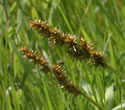 Carex stipata plant
Carex stipata plant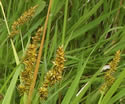 Carex stipata plant
Carex stipata plant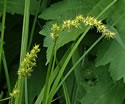 Carex stipata plant
Carex stipata plant Carex stipata on Lake Superior's north shore
Carex stipata on Lake Superior's north shore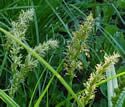 flowering Carex stipata
flowering Carex stipata septate-nodulose sheath
septate-nodulose sheath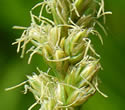 flowering spikes
flowering spikes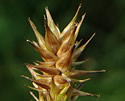 mature spikes
mature spikes
Photos by K. Chayka taken in Cook, Pine and Ramsey Counties. Photos courtesy Peter M. Dziuk taken in Pope, Ramsey and Winona counties. Photos courtesy Steve Eggers taken in Dakota County.
Comments
Have you seen this plant in Minnesota, or have any other comments about it?






